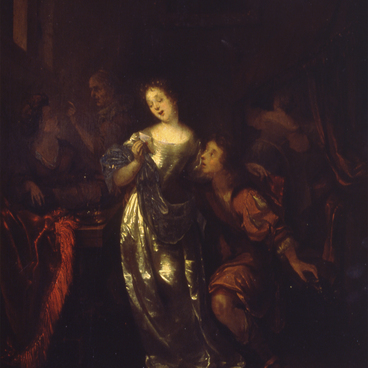The Antwerp painter Simon Johannes van Douw is known as a master of hunting and battles scenes, as well as horse markets. Hunting was one of the nobility’s favourite entertainments and such pictures were extremely popular.
The scene is depicted against the background of an Italian landscape with a castle and contours of mountains visible afar. Early morning, the hunters are getting ready to depart for hunting after spending the night in the roadside hotel. The hotel, a massive stone building with peeled off stucco, is located on the left, while in the right-hand part the painter leaves an open space thus emphasizing its depth.
All people in the picture are slightly similar to each other, with doll-like faces, big eyes, turned-up noses. But the horses and dogs in the picture are very different for Simon Johannes van Douw was a fine animalist, a big connoisseur of horses and dogs. For this reason, images of animals shown at various, complex angles were particularly successful. All the figures are static, but the painter managed to convey tension that gripped all those present in anticipation of the hunt, hidden inner motion.
An important instrument of the master here is the rhythm. Turns of heads, pointing gestures of hands, bent legs of the horses — all this gives a sense of tense waiting. The light of the morning, cold sky forms a common reflex on objects. All colours are of a coldish, somewhat gloomy tint. Thus, the brown wall becomes gray-brown, the ground becomes lilacky-brown and greenish-brown, white areas acquire a barely noticeable bluish-gray hue.
Such a semi-tonal colouring renders the feeling of air in the picture while the local spots of clothes of the white, red, blue colour intensify the rhythm, motion, tension. Therefore, both the composition and colouration of the picture serve one prime task — to show a moment of restless tension that gripped all characters of the picture before departure for hunting.
This picture is not only a model of craftsmanship of the Flemish painter of the 17th century, but is also an example of a very good job done by the museum’s restorer. It arrived at the museum in a very poor condition. As is clear from the restoration certificate, the author’s canvas was deformed and torn in more than 20 places. Earlier the picture had been restored unprofessionally a number of times. In the process multiple entries and tonings were made that distorted the original painting. The picture got a new life thanks to Vladimir Solyanov, a remarkable museum restorer.



